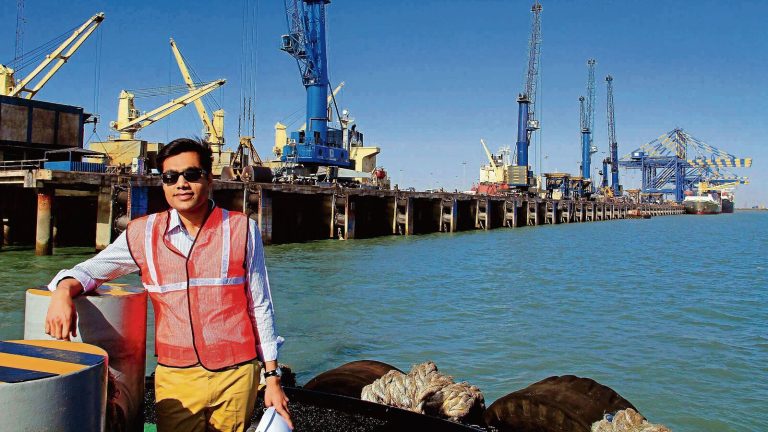“We have more cash flow than we can utilize,” said Karan Adani, the company’s managing director. Excess cash on hand has resulted in the company’s leverage ratios falling to a suboptimum level, he said.
The company is looking for organic and inorganic expansion opportunities, particularly in Southeast Asia and East Africa, said the elder son of Adani Group founder and chair Gautam Adani.
APSEZ also plans to invest ₹11,000-12,000 crore in capital expenditures over the course of FY26, chief executive Ashwani Gupta said. About half of this money will go to expanding capacity at its existing 16 ports. The rest will go into growing its logistics and marine services portfolio, operations technology, and decarbonization. The company will also buy more trucks to increase its footprint in inland logistics.
“Even the current debt level is not very healthy for us. For an infrastructure business, net debt to Ebitda should ideally be at 3 to give the best return to our investors. We are at 1.9, which is not a good sign,” Adani said, adding that the ratio is likely to further drop to 1.5.
“That’s something that we have to work towards. The team has to find good quality assets at the right price and be out there in the market to look at all the opportunities out there,” he said, glancing at CEO Gupta.
Bringing transhipment back to India
Located near the southern tip of India and about 20 kilometres from a major East-West shipping corridor, the Vizhinjam port aims to become a transhipment hub. Large container vessels, called mother ships, travelling between major ports can drop off and pick up cargo at a transhipment hub. In layperson’s terms, that would be the equivalent of Dubai being a hub for international air travel.
According to a company statistic, about three-quarters of Indian cargo transhipment happens at overseas ports like Colombo, Singapore, and Dubai. This is because most Indian ports are far from major international shipping routes or are not deep enough to handle large mother ships.
“Give us a year, and you will see that all Indian cargo will get trans-shipped here rather than predominantly internationally,” Karan Adani said. “The ultimate goal is to help in terms of reducing the shipping cost for the Indian exporters and importers.”
Adani said the Vizhinjam port began commercial operations in December and has already exceeded its capacity of handling 1 million twenty-foot-equivalent units (TEU) of cargo a year.
The port will reach 5 million TEU capacity by 2028 as APSEZ invests ₹13,000 crore in a second phase that will include expanding both the berth and the breakwater, he said.
To be sure, Vizhinjam’s cargo handling charges won’t be any cheaper than those of its overseas rivals. But its proximity to other Indian ports and use of the latest technology would help cut turnaround times, saving cost.
Growth opportunities
FY25 was a good year for APSEZ, per its earnings report on Thursday. It posted a record profit of ₹11,061 crore while also completing the acquisition of Gopalpur port in Odisha and commencing operations at Vizhinjam and Colombo.
It handled 450 million metric tonnes of cargo, raking in a topline of ₹31,079 crore. The company has set a target of handling 1 billion tonnes of cargo annually by 2030, 150 million tonnes of which will come from its overseas ports in Israel, Tanzania, Sri Lanka and Australia.
The company had a cash balance of ₹8,991 crore as of 31 March. For FY25, the APSEZ board recommended a dividend of ₹7 per share, translating to a payout of ₹1,500 crore.
APSEZ is planning to bid for the upcoming Vadhavan Port when it comes up for bidding, Adani said.
Other growth opportunities include the planned India-Middle East-Europe Economic Corridor (IMEC). APSEZ stands to gain from the route, given its control of Vizhinjam, a terminal in Colombo, a port in Tanzania, and the Haifa port in Israel. All of these fall along the planned trade route, which promises to be an alternative to the Suez Canal and a counter to China’s belt and road initiative.
The company’s board last month approved buying back the NQXT port terminal in Australia from the Adani family, which it had sold to them in 2013 to pare debt. Gupta said the company is eyeing green hydrogen export opportunities from there.
The APSEZ stock closed 4.1% higher on the BSE on Friday at ₹1,267.05. The benchmark Sensex ended the session 0.3% in the green.
Key takeaways
- Adani Ports generates more cash than it can efficiently deploy, leading to lower-than-optimal leverage ratios.
- The company is seeking growth opportunities, both organic and inorganic, especially in Southeast Asia and East Africa.
- The newly inaugurated Vizhinjam Transhipment Port aims to reduce reliance on overseas hubs like Colombo and Singapore for Indian cargo.
- APSEZ plans to invest ₹11,000-12,000 crore in FY26, focusing on port capacity expansion, logistics, and decarbonization efforts.
- The company targets handling 1 billion tonnes of cargo annually by 2030, including 150 million tonnes from international ports.


